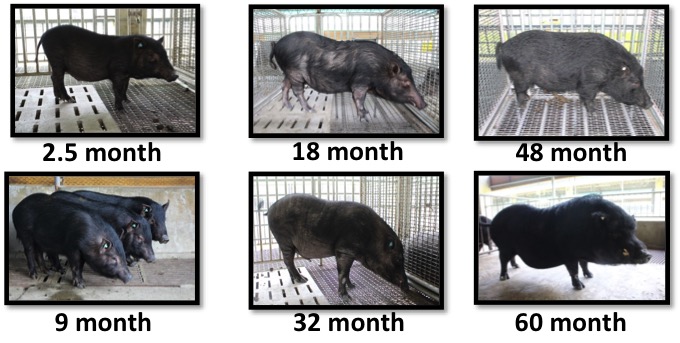Introduction: The global age in this world is growing old fast. According to world health organization, the elderly of 60 and above will constitute two billion people worldwide by 2050.Aging is accompanied with various diseases such as cancer, diabetes, and neurodegenerative diseases. As a result, skin aging study is important in order to understand problems during aging. However, human individuals are not suitable for such skin study; thus, animal model is needed for substitution.
Materials and Methods: Animals: For this study seventeen male Lanyu pig in eight groups were used: 1 month-old(n=2), 2.5 month- old(n=6), 9 month-old(n=3), 18 month-old(n=2), 32 month-old(n=1), 41 month-old(n=1), 48 month- old(n=1) and 60 month-old(n=1). The pigs were penned individually to minimize the risk of chamber rupture. The environment was controlled to remain within temperature range of 23 to 28°C, 65% humidity, and the a light cycle of 12 hours on and 12 hours off. The animal were fed 1.25 to 600 to 1000 g of standard swine diet, depending on age, and received an uninterrupted supply of clean, fresh water. All animal procedures were approved by the National Cheng Kung University laboratory animal center.

Tissue sample collection and preparation: The tissue sample was collected from different age Lanyu pig by BiopsyPuncher.The cut-out tissue sample was washed with PBS, fixed in 10% formalin solution for 24-48 hours. After fixation, tissues were dehydrated and washed again to be embedded in paraffin. Tissue sections of 5 μm were prepared for histological staining.
Histological study: The Lanyu pig skin section prepared from different part of Lanyu pig, immediately fixed in 10% neutral buffered formalin and embedded in paraffin. The paraffin sections (5μm) were made from formalin-fixed samples and stained using hematoxylin and eosin(H&E stain), picro-sirius red staining and Verhoeff's elastin staining.
Result and Discussion: The lateral side of pig`s dorsal skin area has been previously studied[1] and Lanyu pig was analyzed in our lab using . Analysis of Lanyu pig showed no significant different in the lateral dorsal skin area. Here, the 1, 9, and 48 month-old Lanyu pigs were studied in which dermal layer was found to increase, and epidermal layer to have decreased in thickness with increasing age.

Type Ⅰand Ⅲ collagen were the main collagen in the dermal layer. The Type Ⅲ collagen was shown to be increased in expression level and grew rough in appearance with increasing age. This was further confirmed in the previous research on 0-90 year-old humans, showing that Type Ⅲ collagen increased in the elderly compared to in the youngsters[2]. In consistent, Type Ⅲ collagen increased with increasing age and in overall collagen content in the Lanyu pig.

The formation of elastic fibers is due to microfibrils interacting with elastin proteins in the basal layer below epidermis, and further interactions with the epidermis-dermis boundary region. This complex connection formed a network of elastic fibers. Increasing age may lead to increasing proteinase that degrade elastic fibers, forming less elongated elastic fibers, and may exist in the degenerated form due to long half-life of elastic fibers[3]. In consistent, the degenerated form of elastic fibers with increasing age was reported in aging human.
Conclusion: In conclusion, the age effect on skin in Lanyu pig is not completely identical to that in human; however, several skin structures were found to be identical between Lanyu pig and human.
The work was supported by grants MOST 104-2622-B-006-014 and CZ-20-18-146-103 from the National Science Council, R.O.C.
References:
[1] Variation assessment for in vitro permeabilities through Yucatan micropig skin.
[2] Collagens--structure, function, and biosynthesis.
[3] Molecular aspects of skin ageing.